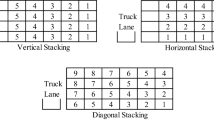Abstract
This paper studies a storage yard management problem in a transshipment hub where the loading and unloading activities are both heavy and concentrated. In order to reduce the number of reshuffles, which helps to reduce the vessel turnaround time, the port operator uses the consignment strategy to group export and transshipment containers according to their destination vessel. To reduce the potential traffic congestion of prime movers, a high–low workload balancing protocol is used. A mixed integer programming model is formulated to determine the storage locations of incoming containers, the number of incoming containers and the smallest number of yard cranes to deploy in each shift. An iterative improvement method is developed to solve the problem, in which a tabu search based heuristic algorithm is used to generate an initial yard template, and then the generated yard template is improved by an improvement algorithm iteratively until an optimal or a satisfactory solution is obtained. Experiment results show that the proposed method can generate excellent results within a reasonable time, even for the extreme cases.
Similar content being viewed by others
References
Chen T (1999) Yard operations in the container terminal—a study in the “unproductive moves”. Maritime Policy Manage 26(1): 27–38
Chen CY, Chao SL, Hsieh TW (2000) A time-space network model for the space resource allocation problem in container marine transportation. Paper presented at the 17th international symposium on mathematical programming, Atlanta, USA
Chung YG, Randhawa SU, Mcdowell ED (1988) A simulation analysis for a transtainer-based container handling facility. Comput Indus Eng 14(2): 113–115
De Castilho B, Daganzo CF (1993) Handling strategies for import containers at marine terminals. Trans Res B 27(2): 151–166
Dekker R, Voogd P, Asperen E (2006) Advanced methods for container stacking. OR Spectrum 28(4): 563–586
Gambardella LM, Rizzoli AE, Zaffalon M (1998) Simulation and planning of an intermodal container terminal. Simulation 71(2): 107–116
Holguín-Veras J, Walton CM (1996) On the development of a computer system to simulate port operations considering priorities. In: Proceedings of the 28th conference on winter simulation. ACM Press, New York, pp 1471–1478
Kim KH (1997) Evaluation of the number of reshuffles in storage yards. Comput Indus Eng 32(4): 701–711
Kim KH, Bae JW (1998) Re-marshaling export containers in port container terminals. Comput Indus Eng 35: 655–658
Kim KH, Kim HB (1999) Segregating space allocation models for container inventories in port container terminals. Int J Product Econo 59: 415–423
Kim KH, Kim HB (2002) The optimal sizing of the storage space and handling facilities for import containers. Transp Res B 36: 821–835
Kim KH, Park YM, Ryu KR (2000) Deriving decision rules to locate export containers in storage yards. Euro J Oper Res 124: 89–101
Kim KH, Park KT (2003) A note on a dynamic space-allocation method for outbound containers. Eur J Oper Res 148(1): 92–101
Kozan E, Preston P (1999) Genetic algorithms to schedule container transfers at multimodal terminals. Int Trans Opera Res 6(3): 311–329
Kozan E, Preston P (2006) Mathematical modeling of container transfers and storage locations at seaport terminals. OR Spectrum 28(4): 519–537
Lee LH, Chew EP, Tan KC, Han Y (2006) An optimization model for storage yard management in transshipment hubs. OR Spectrum 28(4): 539–561
Murty KG, Liu J, Wan Y, Linn R (2005) A decision support system for operations in a container terminal. Decis Support Syst 39(3): 309–332
Preston P, Kozan E (2001) An approach to determine storage locations of containers at seaport terminals. Comput Oper Res 28: 983–995
Sculli D, Hui CF (1988) Three dimensional stacking of containers. Omega 16(6): 585–594
Stahlbock R, Voβ S (2008) Operations research at container terminals: a literature update. OR Spectrum 30(1): 1–52
Steenken D, Voβ S, Stahlbock R (2004) Container terminal operation and operations research—a classification and literature review. OR Spectrum 26: 3–49
Taleb-Ibrahimi M, De Castilho B, Daganzo CF (1993) Storage space vs handling work in container terminals. Transp Res B 27: 13–32
Vis IFA, de Koster R (2003) Transshipment of containers at a container terminal: an overview. Eur J Oper Res 147: 1–16
Zhang C, Liu J, Wan YW, Murty KG, Linn RJ (2003) Storage space allocation in container terminals. Transp Res B 37: 883–903
Author information
Authors and Affiliations
Corresponding author
Rights and permissions
About this article
Cite this article
Han, Y., Lee, L.H., Chew, E.P. et al. A yard storage strategy for minimizing traffic congestion in a marine container transshipment hub. OR Spectrum 30, 697–720 (2008). https://doi.org/10.1007/s00291-008-0127-6
Published:
Issue Date:
DOI: https://doi.org/10.1007/s00291-008-0127-6




